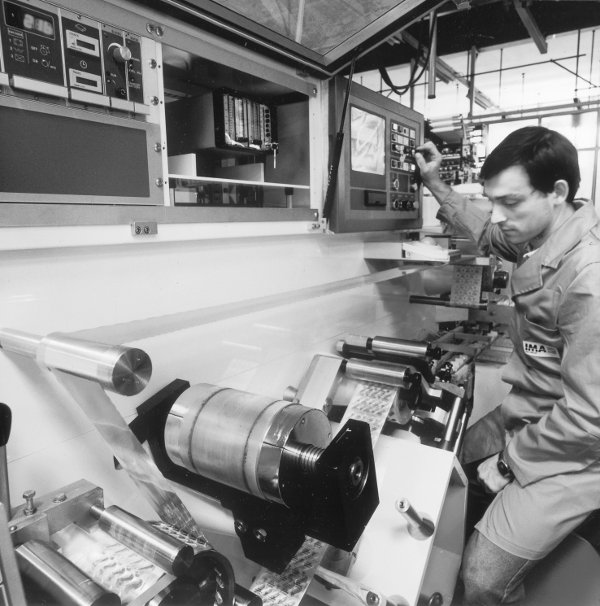Local Industry the "packaging valley"
The manufacturing of automatic machines in Bologna

Detail of an automatic machine for the packaging of tea - 1970s (photo © IMA Industries)
The automation industry in Bologna has its roots in the Middle Ages and the Renaissance. The silk mills of Bologna, mentioned in Leonardo da Vinci’s manuscripts, were among the world’s most advanced centers of production. Their technological secrets were carefully guarded from watchful eyes by social behaviors and municipal laws, which was easier if manufacturing was concentrated in a relatively small area. This pre-modern textile district was the precursor of today’s packaging valley.
With the industrial revolution, Italy (and Bologna in particular) gradually lost their importance and innovative edge. The technological renaissance, which led to the modern packaging district in Bologna, began in 1924. In that year Gaetano Barbieri – partner of Arturo Gazzoni (the famous inventor of the carbonated powder Idrolitina) opened a small workshop in Bologna, which later became ACMA (Anonima Costruzioni Macchine Automatiche), the leading Italian manufacturer of machines in the 1930s.
ACMA had immediate success in Italy and abroad: from the '30s and '40s production for export has been extremely important for the company and later for the whole district. ACMA’s machines were easy to use, compact, and versatile. They were designed and developed by a team of young and forward-looking designers led by Bruto Carpigiani. The forefather of several generations of entrepreneurs and design engineers, he was the key figure in the rising of the packaging district. Many of the technicians led by Carpigiani had been trained at the renowned Istituto Tecnico Aldini-Valeriani, a local technical high school, modeled on British examples. After its foundation in 1844, for many decades it provided future artisans, workers, and entrepreneurs with advanced technical training.

Technician working on a blister packaging machine - 1970s (photo © IMA Industries)
Companies grew one after another in the Bologna packaging district. All of them were of small and medium size, and were started by people who had no engineering degrees but held great passion for machines and benefited from the help and involvement of their families.
The industry had a new start after World War II and grew particularly fast during the '60s and '70s. The post-war economic boom brought a rise of the mass production and consumption of packaged goods. This required the automation of the measuring and boxing up procedures in order to decrease the workforce and to achieve better product preservation, precise measurement, and stricter hygiene. The budding Bologna packaging district seized the opportunity, and became a successful rival of its prominent German competitors.
During the period from 1945 to 1960, several new companies split off from ACMA and SASIB (another illustrious ancestor of the district, working in the field of cigarette packaging). These new firms emphasized flexibility and high customization, committed to meet the customer needs whenever feasible. Their clients were much more interested in quality and strict adherence to their specifications than cost cutting. This remains a characteristic feature of the district, particularly valuable in today’s global economy.
These are a few successful examples of such postwar start-ups: Ariosto Seragnoli helped his cousin Enzo to found G.D and the company is now the world leader in the packaging of tobacco. Antonio Martelli, after working at ACMA, founded CAM, which opened the door to the pharmaceutical sector for other companies in the area. He was soon followed by Andrea Romagnoli’s IMA and later by Marchesini and MG2, which are now major suppliers of automation in the highly sophisticated and hyper-regulated Pharma business.

Technician working on a capsule filling machine - 1980s (photo © IMA Industries)
Bologna’s automation district is nowadays a complex web of interconnected companies - sometimes in competition with one another - who increasingly rely on innovation for their success. It seems, now is no longer a time for brave pioneers founding niche businesses with little capital and a lot of passion and ideas for applied mechanics. These days, an automated machine is no longer conceived by an individual creative mind but by a team of people, and huge investments are needed to finance that. Moreover, we witness the emergence of truly “mechatronical” products, developed with expertise from mechanics, electronics and informatics.
People hired today are largely from engineering faculties, though the development of automatic machines still requires long test sessions at workshops - in addition, of course, to complex designing with the aid of CAD systems and programming languages. The knowledge transfer from fitters to designers remains, thus, essential in the invention and manufacturing of new products, especially so in a district that considers tailor-made production as its distinctive trademark.
Further readings (in Italian)
- Alaimo A., Capecchi V., L'industria delle macchine automatiche a Bologna: un caso di specializzazione flessibile, in: Distretti, imprese, classe operaia, eds. P.P. D'Attore and V. Zamagni, Milan, 1992.
- Campigotto A., Curti R., Grandi M., Guenzi A., Prodotto a Bologna, una identità industriale con cinque secoli di storia, Bologna, 2000.
- Curti R., Grandi M., Per niente fragile: Bologna capitale del packaging, Bologna, 1997.
Text and copyright by Daniele Portolan.
Pictures courtesy of IMA S.p.a.